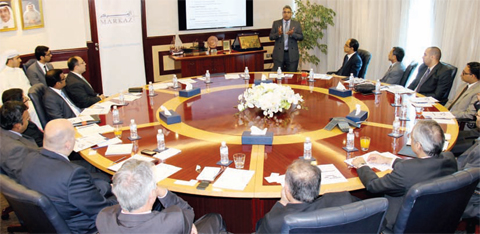 KUWAIT: M.R. Raghu, Head of Research, Kuwait Financial Centre "Markaz" recently presented his viewpoints on calculating the 'Cost of Capital' whichis of prime importance in corporate finance decision making. The presentation was held at Kuwait Banking Association yesterday with the participation of major banks in Kuwait.
KUWAIT: M.R. Raghu, Head of Research, Kuwait Financial Centre "Markaz" recently presented his viewpoints on calculating the 'Cost of Capital' whichis of prime importance in corporate finance decision making. The presentation was held at Kuwait Banking Association yesterday with the participation of major banks in Kuwait.
The presentation pointed out that in the GCC, unlisted companies outnumber listed companies by miles and hence most of the deals involve unlisted companies in one way or other. Corporate finance professionals face twin problem while valuing an unlisted company. They have to estimate future cash flows and also estimate the appropriate "discount rate" at which these cash flows can be discounted to the present. Such a discount rate is nothing but the cost of capital adjusted for the weights of capital in the capital structure.
WACC Methodology
Raghu added, 'Opportunity cost' also referred to as 'hurdle cost' or 'discount rate' is of primary importance in valuation and helps the management in identifying projects which add value to the enterprise. Given the importance of this metric in creating value for shareholders, it' is essential to understand how it is computed. Though, in reality, it's surprising to note that not much effort is diverted towards the calculation of cost of capital; while a significant amount of time is focussed on forecasting uncertain future cash flows. Improper capital cost assumptions could lead to type-I error (accepting projects that don't add shareholder value) or type-II error (rejecting projects that add shareholder value).
In order to compute the cost of capital, we start by finding the cost of each capital component that the firm utilizes. Cost of capital primarily consists of equity and debt costs, weighed according to the proportions of debt and equity capital in the capital structure. The cost of debt can be inferred easily as it entails specific cost in the form of interest payments made in cash. The entire debt mix including money market debt in the form of commercial papers/notes, bank debt in the form of loans/overdraft, financial leases and bonds raised is aggregated. The interest payments made as a proportion of interest bearing debt instruments provides us with the debt cost.
Unlike debt holders, equity holders do not demand an explicit return on their capital. However, equity holders incur an implicit opportunity cost for investing in a specific company, because they could invest in an alternative company with similar risk profile. Equity cost involves various factors such as risk free asset, beta, market risk premium, country risk premium among others. Beta - a measure of priced risk, which is arrived by regressing the past price returns on an index. As private firms do not trade, estimation of beta becomes problematic for private firms.
In order to estimate the value of beta for a private firm, we create a list of comparable public firms from the same line of industry. Firms with similar line of business and asset size would typically be considered as a good comparable. To ensure we have zeroed down on appropriate comparable enterprise, a simple regression test between the revenues could be done. Firms which are affected by similar economic and industry factors, in general, would exhibit higher correlation.
Once the comparable list is drawn from listed companies, we may average their beta values and leverage ratios to arrive at levered beta for the particular sector or industry. This levered beta is then unlevered to arrive at the beta for the industry/sector. The unlevered beta could then be levered based on the debt to equity (D/E) ratio for the private firm. One may either use the management target set for debt to equity ratio or the industry average to re-lever the unlevered beta. Considering this as beta for the private firm, we proceed with the calculation of cost of equity using the Capital Asset Pricing Model (CAPM)
Why does WACC vary widely?
Cost of equity is subjective as different people use different methods to compute beta. Some use monthly data for past 5 years while others prefer weekly data for past 3 years. As beta is derived based on historical price data, few adjust it under the assumption that the beta value would revert towards the mean value of 1 over the long period. Difference in equity cost would lead to a range of values for cost of capital.
Risk-free rate and equity risk premium values are dynamic in nature and change with time depending on the market perception of risk.In good times, ERP is compressed - due to lack of risk events, which lowers the equity cost and subsequently capital costs. This would make most projects attractive as with a lower discount/hurdle rate, it would be value accretive. While in bad times, risk events erupt and the same gets priced in leading to expansion of ERP. Higher costs of capital could affect the ability to initiate projects, as they wouldn't add value when expected cash flows are discounted at higher discount rate. Stalled investments are usually a fall out of this.
Given the challenging and dynamic nature of capital costs, it would be a good practice to have a range of values for capital costs, depending on different scenarios. Sensitivity and scenario analysis are particularly helpful in such circumstances to understand the implications of various capital cost assumptions and its potential impact on the project.










